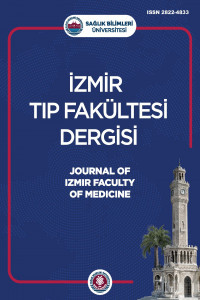Yoğun Bakımda Takip Edilen Entübe Hastalarda Bronşial Aspirasyon Sıvında NGAL ve KIM-1 Varlığının Mortalite Üzerine Etkisi
yoğun bakım, biyobelirteç, mortalite, sepsis
The effect of the presence of NGAL and KIM-1 in the bronchial aspiration fluid on mortality in intubated patients followed in the intensive care unit
___
- 1.Seymour CW, Liu VX, Iwashyna TJ, Brunkhorst FM, Rea TD, Scherag A, et al. Assessment of clinical criteria for sepsis: for the third international consensus definitions for sepsis and septic shock (Sepsis-3). JAMA. 2016;315(8):762.
- 2.Fleischmann C, Scherag A, Adhikari NKJ, Hartog CS, Tsaganos T, Schlattmann P et al. Assessment of global incidence and mortality of hospital-treated sepsis current estimates and limitations. Am J Respir Crit Care Med. 2016;193:259–72.
- 3.Salomão R, Ferreira BL, Salomão MC, Santos SS, Azevedo LCP, Brunialti MKC. Sepsis: Evolving concepts and challenges. Brazilian J Med Biol Res. 2019;52:e8595.
- 4.Santiago-Sánchez GS, Pita-Grisanti V, Quiñones-Díaz B, Gumpper K, Cruz-Monserrate Z, Vivas-Mejía PE. Biological functions and therapeutic potential of lipocalin 2 in cancer. Int J Mol Sci. 2020;21:4365.
- 5.Crescenzi E, Leonardi A, Pacifico F. NGAL as a potential target in tumor microenvironment. Int J Mol Sci. 2021;22:12333.
- 6. Candido S, Maestro R, Polesel J, Catania A, Maira F, Signorelli SS et al. Roles of neutrophil gelatinase-associated lipocalin (NGAL) in human cancer. Oncotarget. 2014;5:1576–94.
- 7.Bolignano D, Donato V, Lacquaniti A, Fazio MR, Bono C, Coppolino G et al. Neutrophil gelatinase-associated lipocalin (NGAL) in human neoplasias: A new protein enters the scene. Cancer Lett. 2010;288:10–6.
- 8.Li Yang, Craig R Brooks, Sheng Xiao, Venkata Sabbisetti, Melissa Y Yeung, Li-Li Hsiao et al. KIM-1-mediated phagocytosis reduces acute injury to the kidney J Clin Invest. 2015;125:1620-36.
- 9.Liu L, Song Z, Zhao Y, Li C, Wei H, Ma J et al. HAVCR1 expression might be a novel prognostic factor for gastric cancer. PLoS One. 2018;13:e0206423.
- 10.Zheng X, Xu K, Chen L, Zhou Y, Jiang J. Prognostic value of TIM-1 expression in human non-small-cell lung cancer. J Transl Med. 2019;17:178.
- 11.Al-Bataineh MM, Kinlough CL, Mi Z, Jackson EK, Mutchler SM, Emlet DR et al. KIM-1-mediated anti-inflammatory activity is preserved by MUC1 induction in the proximal tubule during ischemia-reperfusion injury. Am J Physiol - Ren Physiol. 2021;321:F135–48.
- 12.Singer M, Deutschman CS, Seymour C, Shankar-Hari M, Annane D, Bauer M et al. The third international consensus definitions for sepsis and septic shock (Sepsis-3). JAMA. 2016;315:801-10.
- 13.Lisowska-Myjak B. Serum and urinary biomarkers of acute kidney injury. Blood Purif. 2010;29:357-65.
- 14.Kjeldsen L ,Johnsen AH, Sengeløv H, Borregaard N. Isolation and primary structure of NGAL, a novel protein associated with human neutrophil gelatinase. J Biol Chem. 1993;268:10425-32.
- 15.Hvidberg V, Jacobsen C, Strong RK, Cowland JB, Moestrup SK, Borregaard N. The endocytic receptor megalin binds the iron transporting neutrophil-gelatinase-associated lipocalin with high affinity and mediates its cellular uptake. FEBS Lett. 2005;579:773-7.
- 16.Goetz DH , Holmes MA, Borregaard N, Bluhm ME, Raymond KN, Strong RK. The neutrophil lipocalin NGAL is a bacteriostatic agent that interferes with siderophore-mediated iron acquisition. Mol Cell. 2002;10:1033-43.
- 17.Chakraborty S, Kaur S, Guha S, Batra SK. The multifaceted roles of neutrophil gelatinase associated lipocalin (NGAL) in inflammation and cancer. Biochim Biophys Acta. 2012;1826:129-69.
- 18.Laxminarayana R Devireddy , Claude Gazin, Xiaochun Zhu, Michael R Green. A cell-surface receptor for lipocalin 24p3 selectively mediates apoptosis and iron uptake. Cell. 2005;123:1293-305.
- 19.Schmidt-Ott KM, Mori K, Li JY, Kalandadze A, Cohen DJ, Devarajan P et al. Dual action of neutrophil gelatinase–associated lipocalin. J Am Soc Nephrol. 2007;18:407-13.
- 20.Yang J, Goetz D, Li J, Wang W, Mori K, Setlik D, et al. An iron delivery pathway mediated by a lipocalin. Mol Cell. 2002;10:1045-56.
- 21.Fjaertoft G, Foucard T, Xu S, Venge P. Human neutrophil lipocalin (HNL) as a diagnostic tool in children with acute infections: A study of the kinetics. Acta Paediatr. 2007;94:661–6.
- 22.Katano M, Okamoto K, Arito M, Kawakami Y, Kurokawa MS, Suematsu N et al. Implication of granulocyte-macrophage colony-stimulating factor induced neutrophil gelatinase-associated lipocalin in pathogenesis of rheumatoid arthritis revealed by proteome analysis. Arthritis Res Ther. 2009;11:R3
- 23.Moniaux N , Chakraborty S, Yalniz M, Gonzalez J, Shostrom VK, Standop J. Early diagnosis of pancreatic cancer: neutrophil gelatinase-associated lipocalin as a marker of pancreatic intraepithelial neoplasia. Br J Cancer. 2008;98:1540-7.
- 24.Yndestad A, Landrø L, Ueland T, Dahl CP, Flo TH, Vinge LE et al. Increased systemic and myocardial expression of neutrophil gelatinase-associated lipocalin in clinical and experimental heart failure. Eur Heart J. 2009;30:1229-36.
- 25.Huo W, Zhang K, Nie Z, Li Q, Jin F. Kidney injury molecule-1 (KIM-1): a novel kidney-specific injury molecule playing potential double-edged functions in kidney injury. Transplant Rev (Orlando). 2010;24:143-6.
- 26.Bailly V , Zhang Z, Meier W, Cate R, Sanicola M, Bonventre JV. Shedding of kidney injury molecule-1, a putative adhesion protein involved in renal regeneration. J Biol Chem. 2002;277:39739-48.
- 27.Vaidya VS, Ramirez V, Ichimura T, Bobadilla NA, Bonventre J V. Urinary kidney injury molecule-1: A sensitive quantitative biomarker for early detection of kidney tubular injury. Am J Physiol Renal Physiol. 2006;290:F517-29.
- Başlangıç: 2022
- Yayıncı: Sağlık Bilimleri Üniversitesi
Erişkin Nefrotik Sendromlu Olgularda Hiperüriseminin Böbrek Sonlanımları Üzerine Etkisi
Mustafa UBAY, Berna EREN, Funda TAŞLI
Dağıstan BOZKURT, Celal Buğra SEZEN, Yaşar SÖNMEZOĞLU, Muzaffer METİN
Meme Kanserlerinde ETS-İlişkili Genin (ERG) Prognostik Önemi
Gulden DİNİZ, İsmail Eren BİROL, Tekincan Çağrı AKTAŞ, Dudu SOLAKOĞLU KAHRAMAN, Cem KARAALİ, Pınar AYVAT
Celal Buğra SEZEN, Gamze TANRIKULU, Ayşegül ÇİFTÇİ, Dilekhan KİZİR, Özkan SAYDAM, Muzaffer METİN
Buse SOYSAL, Senem ALKAN ÖZDEMİR, Tülin GÖKMEN YILDIRIM, Şebnem ÇALKAVUR
Mikroorganizmaların Keşfi ve Mikrobiyolojinin Tarihçesi
Gulden DİNİZ, Emine Müge KARAKAYALI, İlke AYCAN, Gizem ERTÜRK, Gizem UYSAL
Disfonksiyonel İşemeli Hastalarda Kronik Böbrek Hastalığı Gelişimi İçin Risk Faktörleri
Özgür ÖZDEMİR ŞİMŞEK, Dilnur SEVİNÇ, Gökçen ERFİDAN, Seçil ARSLANSOYU ÇAMLAR, Belde KASAP DEMİR, Fatma MUTLUBAŞ, Demet ALAYGUT, Sibel TİRYAKİ
Elçin ERDOĞAN YÜCEL, Boran YAVUZ, Aylin Fatma KARATAŞ, İnci ALACACIOĞLU, Sermin ÖZKAL, Oğuz DİÇLE, Mustafa SEÇİL, Hayri ÖZSAN
Alt Ekstremite Rekonstrüksiyonu: 5 Yıllık Klinik Deneyim
Soysal BAŞ, Sabri ÖZTÜRK, Hatice Aylin AKBULUT, Çağatay ÖNER
